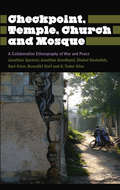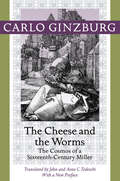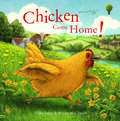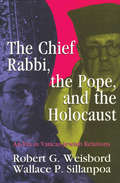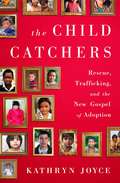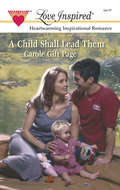- Table View
- List View
Checkpoint, Temple, Church and Mosque: A Collaborative Ethnography of War and Peace (Anthropology, Culture and Society)
by Bart Klem Kalinga Tudor Silva Benedikt Korf Jonathan Spencer Jonathan Goodhand Shahul HasbullahIs religion best seen as only a cause of war, or is it a source of comfort for those caught up in conflict? In Checkpoint, Temple, Church and Mosque six senior figures in Anthropology, Sociology, Geography and Development Studies set out to answer this question. *BR**BR*Based on fieldwork conducted in Sri Lanka's most religiously diverse and politically troubled region during the country's civil war (1983-2009), it provides a series of new and provocative arguments about the promise of a religiously based civil society, and the strengths and weaknesses of religious organisations and religious leaders in conflict mediation. *BR**BR*The authors argue that for people trapped in long and violent conflicts, religion ultimately plays a contradictory role, and that its institutions are themselves profoundly affected by war - producing a complex picture in which Catholic priests engage with Buddhist monks and new Muslim leaders, and where Hindu temples and Pentecostal churches offer the promise of healing.
Checkpoint, Temple, Church and Mosque: A Collaborative Ethnography of War and Peace (Anthropology, Culture and Society)
by Jonathan Spencer Jonathan Goodhand Shahul Hasbullah Bart Klem Benedikt Korf Kalinga Tudor SilvaIs religion best seen as only a cause of war, or is it a source of comfort for those caught up in conflict? In Checkpoint, Temple, Church and Mosque six senior figures in Anthropology, Sociology, Geography and Development Studies set out to answer this question. *BR**BR*Based on fieldwork conducted in Sri Lanka's most religiously diverse and politically troubled region during the country's civil war (1983-2009), it provides a series of new and provocative arguments about the promise of a religiously based civil society, and the strengths and weaknesses of religious organisations and religious leaders in conflict mediation. *BR**BR*The authors argue that for people trapped in long and violent conflicts, religion ultimately plays a contradictory role, and that its institutions are themselves profoundly affected by war - producing a complex picture in which Catholic priests engage with Buddhist monks and new Muslim leaders, and where Hindu temples and Pentecostal churches offer the promise of healing.
The Cheese and the Worms: The Cosmos of a Sixteenth-Century Miller
by Carlo GinzburgThe Cheese and the Worms is an incisive study of popular culture in the sixteenth century as seen through the eyes of one man, the miller known as Menocchio, who was accused of heresy during the Inquisition and sentenced to death. Carlo Ginzburg uses the trial records to illustrate the religious and social conflicts of the society Menocchio lived in. For a common miller, Menocchio was surprisingly literate. In his trial testimony he made references to more than a dozen books, including the Bible, Boccaccio's Decameron, Mandeville's Travels, and a "mysterious" book that may have been the Koran. And what he read he recast in terms familiar to him, as in his own version of the creation: "All was chaos, that is earth, air, water, and fire were mixed together; and of that bulk a mass formed—just as cheese is made out of milk—and worms appeared in it, and these were the angels."Ginzburg’s influential book has been widely regarded as an early example of the analytic, case-oriented approach known as microhistory. In a thoughtful new preface, Ginzburg offers his own corollary to Menocchio’s story as he considers the discrepancy between the intentions of the writer and what gets written. The Italian miller’s story and Ginzburg’s work continue to resonate with modern readers because they focus on how oral and written culture are inextricably linked. Menocchio’s 500-year-old challenge to authority remains evocative and vital today.
Chemically Modified Bodies: The Use of Diverse Substances for Appearance Enhancement
by Matthew Hall Sarah Grogan Brendan GoughThis innovative edited collection brings together leading international academics to explore the use of various non-prescription and prescription substances for the purpose of perceived body image enhancement. While studies on drug misuse to date have examined drug use in the context of sporting performance, addiction, and body image for particular groups such as bodybuilders, there has been little research that explores the wider use (and misuse) of legal and illegal drugs for body image development and weight loss. With medical sociology and social psychology at its core, this important volume shows the complex reasons behind the misuse of various medications, how these are connected to contemporary body image and appearance concerns, and why the known health risks and possibly harmful side effects do not act as deterrents.
The Cherished Five in Sikh History
by Louis E. FenechOn the 30th of March, 1699, the Sikh Guru Gobind Singh called together a special assembly at the Keshgarh Fort at Anandpur. Following the morning devotions, the Guru asked for a volunteer, saying, "The entire sangat is very dear to me; but is there a devoted Sikh who will give his head to me here and now? A need has arisen at this moment which calls for a head." One man arose and followed the Guru out of the room. When the Guru returned to the assembly with a bloodied sword, he asked for another volunteer. Another man followed. This was repeated three more times, until at last the Guru emerged with a clean sword and all five men alive and well. Those five volunteers would become the first disciples of the Khalsa, the martial community within the Sikh religion, and would come to be known as the Panj Piare, or the Cherished Five. Despite the centrality of this group to modern Sikhism, scholarship on the Panj Piare has remained sparse. Louis Fenech's new book examines the Khalsa and the role that the the Panj Piare have had in the development of the Sikh faith over the past three centuries.
The Cherished Five in Sikh History
by Louis E. FenechOn the 30th of March, 1699, the Sikh Guru Gobind Singh called together a special assembly at the Keshgarh Fort at Anandpur. Following the morning devotions, the Guru asked for a volunteer, saying, "The entire sangat is very dear to me; but is there a devoted Sikh who will give his head to me here and now? A need has arisen at this moment which calls for a head." One man arose and followed the Guru out of the room. When the Guru returned to the assembly with a bloodied sword, he asked for another volunteer. Another man followed. This was repeated three more times, until at last the Guru emerged with a clean sword and all five men alive and well. Those five volunteers would become the first disciples of the Khalsa, the martial community within the Sikh religion, and would come to be known as the Panj Piare, or the Cherished Five. Despite the centrality of this group to modern Sikhism, scholarship on the Panj Piare has remained sparse. Louis Fenech's new book examines the Khalsa and the role that the the Panj Piare have had in the development of the Sikh faith over the past three centuries.
Chest Pain: A man, a stent and a camper van
by Michael HardingIn late 2018, Michael Harding was in a hotel room in Blanchardstown experiencing severe pains in his chest. He eventually phoned an ambulance and was admitted to hospital, suffering from an acute heart attack. Here, in Chest Pain, he looks at the months before the heart attack when he kept the signs of failing health from his beloved and instead retreated into solitude -- and with his own inimitable style and humour takes us with him through the months after a stent had been inserted in his heart, where he travels the roads of Donegal in a camper van in a journey back to the beloved, and to himself.Chest Pain is a thought-provoking, spell-binding memoir about togetherness and what it means to be alive.
Chester, City of Ghosts
by Mary Ann CameronPeople have lived and died in Chester for over 2,000 years, and stories of ghosts have swirled around the city all that time. What is unusual about the city is the frequency of new sightings – fresh examples of paranormal activity. Chester, City of Ghosts is a handy guide to these hauntings, both past and present, and clearly shows why Chester is in the running for most actively haunted settlement in the country. Read the stories, follow the maps, visit the buildings and soon you will agree – and you might even experience some ghostly activity yourself...
Chesterton and Tolkien as Theologians
by Alison MilbankThis book takes Chesterton's 'natural theology' through fairytales seriously as a theological project appropriate to an intellectual attempt to return to faith in a secular age. It argues that Tolkien's fiction makes sense also as the work of a Catholic writer steeped in Chestertonian ideas and sharing his literary-theological poetics. While much writing on religious fantasy moves quickly to talk about wonder, Milbank shows that this has to be hard won and that Chesterton is more akin to the modernist writers of the early twentieth-century who felt quite dislocated from the past. His favoured tropes of paradox, defamiliarization and the grotesque have much in common with writers like T. S. Eliot, Ezra Pound and James Joyce and their use of the demotic as well as the 'mythic method'. Using Chesterton's literary rhetoric as a frame, the book sets out to chart a redemptive poetics that first decentres the reader from his habitual perception of the world, then dramatizes his self-alienation through the grotesque, before finding in that very alienation a sort of pharmakon through paradox and an embrace of difference. The next step is to change one's vision of the world beyond the self through magic which, paradoxically, is the means by which one can reconnect with the physical world and remove the fetishism and commodification of the object. Chesterton's theology of gift is the means in which this magic becomes real and people and things enter into reciprocal relations that reconnect them with the divine.
Chicago Catholics and the Struggles within Their Church
by Andrew M. GreeleyWhat might one expect to learn from a probability sample study of the Archdiocese of Chicago? Can one form a national portrait of Catholics in the United States from data about Chicago? Certainly, Chicago is unique in its judgments about its clergy. As the eminent Catholic sociologist Andrew M. Greeley argues, it is this very difference that makes rigorous comparisons between Chicago Catholics and other Catholic subpopulations possible. He suggests that history and geography provide a basis for understanding the development of the Catholic Church not just in this specific area, but also in the entire United States. The Catholic Archdiocese of Chicago it composed of two counties, Lake and Cook. At the same time the Catholic population has been pushed up against the boundary of DuPage County by racial change in the city, so that much of the west and south side Catholic population of the city has moved into the southern and western suburbs. In this research area, half of the Catholics have attended college and half of those have attended graduate school. Thus, the conventional image of Chicago as a mix of ethnic immigrant neighborhoods has to be modified-although there are still many new immigrants attending special immigrant parishes. Greeley argues that the official church in Chicago, and by inference elsewhere, has not recognized the community structures that permeate the neighborhoods, that it does not grasp the religious stories that shape its peoples' identity, and it does not understand the intense, if selective, loyalty of the archdiocese to its leadership. As part of this argument, Greeley includes transcriptions of in-depth interviews with former Catholics. This study provides a fascinating window into the world of Catholicism in twenty-first century urban America.
Chicago Catholics and the Struggles within Their Church
by Andrew M. GreeleyWhat might one expect to learn from a probability sample study of the Archdiocese of Chicago? Can one form a national portrait of Catholics in the United States from data about Chicago? Certainly, Chicago is unique in its judgments about its clergy. As the eminent Catholic sociologist Andrew M. Greeley argues, it is this very difference that makes rigorous comparisons between Chicago Catholics and other Catholic subpopulations possible. He suggests that history and geography provide a basis for understanding the development of the Catholic Church not just in this specific area, but also in the entire United States. The Catholic Archdiocese of Chicago it composed of two counties, Lake and Cook. At the same time the Catholic population has been pushed up against the boundary of DuPage County by racial change in the city, so that much of the west and south side Catholic population of the city has moved into the southern and western suburbs. In this research area, half of the Catholics have attended college and half of those have attended graduate school. Thus, the conventional image of Chicago as a mix of ethnic immigrant neighborhoods has to be modified-although there are still many new immigrants attending special immigrant parishes. Greeley argues that the official church in Chicago, and by inference elsewhere, has not recognized the community structures that permeate the neighborhoods, that it does not grasp the religious stories that shape its peoples' identity, and it does not understand the intense, if selective, loyalty of the archdiocese to its leadership. As part of this argument, Greeley includes transcriptions of in-depth interviews with former Catholics. This study provides a fascinating window into the world of Catholicism in twenty-first century urban America.
Chicken Come Home!
by Polly FaberDolly likes to lay her egg in a different place each day, to give her boy a challenge. But on this particular day she's chosen a place to roost that takes her far from home and puts her in lots of danger. Will Dolly manage to get home in time to meet her boy from school?
The Chief Rabbi, the Pope, and the Holocaust: An Era in Vatican-Jewish Relationships
by Wallace P. SillanpoaIn February 1945, Israele Zolli, chief rabbi of Rome's ancient Jewish community, shocked his co-religionists in Italy and throughout the Jewish world by converting to Catholicism and taking as his baptismal name, Eugenio, to honor Pope Pius XII (Eugenio Pacelli) for what Zolli saw as his great humanitarianism toward the Jews during the Holocaust. Almost a half a century after his conversion, Zolli still evokes anger and embarrassment in Italy's Jewish community. This book is the first authoritative treatment of this astonishing story. What induced Zolli to embrace Catholicism will probably never be known. Nonetheless, by painstaking scholarly detective work, through interviews in Italy and elsewhere, through the unearthing of private papers not previous known to exist, and through the study of previous inaccessible archival materials, the authors have succeeded in explaining why Zolli left the Jewish fold and joined the Catholic Church. Like Zolli's rabbinical career, Pius XII's long pontificate tells us much about the Church of Rome and its relationship to the Jewish people, particularly with reference to the issue of conversion. The authors focus on the pontiff's World War II policies vis-A-vis the Jews, a subject that has been heatedly debated since Rolf Hochhuth's The Deputy was performed in the early 1960s. What Pacelli knew abut the extermination of the Jews and when he knew it, what he said and failed to say, are given special attention in this book. Through the examination of previous scholarship and primary materials (including Pius XI's encyclical on race and anti-Semitism, Pacelli's behavior is evaluated to determine if Zolli accurately gauged the Holy Father's efforts to save Jews. This saga of the two Eugenios will interest historians of the Second World War and the Holocaust and students of history alike.
The Chief Rabbi, the Pope, and the Holocaust: An Era in Vatican-Jewish Relationships
by Wallace P. SillanpoaIn February 1945, Israele Zolli, chief rabbi of Rome's ancient Jewish community, shocked his co-religionists in Italy and throughout the Jewish world by converting to Catholicism and taking as his baptismal name, Eugenio, to honor Pope Pius XII (Eugenio Pacelli) for what Zolli saw as his great humanitarianism toward the Jews during the Holocaust. Almost a half a century after his conversion, Zolli still evokes anger and embarrassment in Italy's Jewish community. This book is the first authoritative treatment of this astonishing story. What induced Zolli to embrace Catholicism will probably never be known. Nonetheless, by painstaking scholarly detective work, through interviews in Italy and elsewhere, through the unearthing of private papers not previous known to exist, and through the study of previous inaccessible archival materials, the authors have succeeded in explaining why Zolli left the Jewish fold and joined the Catholic Church. Like Zolli's rabbinical career, Pius XII's long pontificate tells us much about the Church of Rome and its relationship to the Jewish people, particularly with reference to the issue of conversion. The authors focus on the pontiff's World War II policies vis-A-vis the Jews, a subject that has been heatedly debated since Rolf Hochhuth's The Deputy was performed in the early 1960s. What Pacelli knew abut the extermination of the Jews and when he knew it, what he said and failed to say, are given special attention in this book. Through the examination of previous scholarship and primary materials (including Pius XI's encyclical on race and anti-Semitism, Pacelli's behavior is evaluated to determine if Zolli accurately gauged the Holy Father's efforts to save Jews. This saga of the two Eugenios will interest historians of the Second World War and the Holocaust and students of history alike.
Chiesa e Stato: Church-State Relations in Italy within the Contemporary Constitutional Framework
by P. Vincent BucciItaly is left out of most contemporary comparative studies of political systems. This omission can be due neither to any intrinsic unimportance of Italy in Europe, nor to the absence of parallel similarities and differ ences - the prerequisites of comparative explanation - between the Italian and other Western political systems. It may be due to the paucity of case studies of Italian politics, upon which comparisons would have to be based. Professor Bucci's book will contribute toward overcoming this scarcity. Not only is Italy under-represented in comparative studies of post war European politics, but there is also a shortage of monographs dealing with particular aspects of Italian politics since the founding of the Republic, especially in English. I hope that Dr. Bucci's work, which is based exclusively upon original Italian sources, signals the beginning of exploration, more systematic than hitherto, of the goldmine for case studies which post-war Italian politics presents to political scientists.
Chihera in Zimbabwe: A Radical African Feminist Principle
by Ezra Chitando Sophia Chirongoma Munyaradzi NyakudyaZimbabwean social media has been awash with images of a woman character, spirit, or concept called Chihera. Traditionally, a woman descending from the Mhofu (Eland) lineage/totem is known as Chihera. In the cumulative tradition of the Shona (a Zimbabwean ethnic group), Chihera is a fiercely independent, assertive, free spirited, and no nonsense woman. This volume seeks to deepen reflections on the Chihera phenomenon in the context of the search for gender justice in Zimbabwe and Africa. The authors reflect on how this radical indigenous feminist ethic circulating on social media can animate the quest for Zimbabwean and African women’s full liberation from patriarchy and all oppressive forces. They grapple with the issue of generating culturally sensitive theories and approaches to galvanize the struggle for African women’s liberation in post-colonial settings. Second, they locate the Chihera mystique in the context of the practical struggle for women’s empowerment. Third, the volume illustrates how the Chihera phenomenon could be utilized for gender justice in Zimbabwe and beyond.
The Child Catchers: Rescue, Trafficking, and the New Gospel of Adoption
by Kathryn JoyceWhen Jessie Hawkins&’ adopted daughter told her she had another mom back in Ethiopia, Jessie didn&’t, at first, know what to think. She&’d wanted her adoption to be great story about a child who needed a home and got one, and a family led by God to adopt. Instead, she felt like she&’d done something wrong.Adoption has long been enmeshed in the politics of reproductive rights, pitched as a &“win-win&” compromise in the never-ending abortion debate. But as Kathryn Joyce makes clear in The Child Catchers, adoption has lately become even more entangled in the conservative Christian agenda.To tens of millions of evangelicals, adoption is a new front in the culture wars: a test of &“pro-life&” bona fides, a way for born again Christians to reinvent compassionate conservatism on the global stage, and a means to fulfill the &“Great Commission&” mandate to evangelize the nations. Influential leaders fervently promote a new &“orphan theology,&” urging followers to adopt en masse, with little thought for the families these &“orphans&” may already have.Conservative evangelicals control much of that industry through an infrastructure of adoption agencies, ministries, political lobbying groups, and publicly-supported &“crisis pregnancy centers,&” which convince women not just to &“choose life,&” but to choose adoption. Overseas, conservative Christians preside over a spiraling boom-bust adoption market in countries where people are poor and regulations weak, and where hefty adoption fees provide lots of incentive to increase the &“supply&” of adoptable children, recruiting &“orphans&” from intact but vulnerable families.The Child Catchers is a shocking exposé of what the adoption industry has become and how it got there, told through deep investigative reporting and the heartbreaking stories of individuals who became collateral damage in a market driven by profit and, now, pulpit command.Anyone who seeks to adopt—of whatever faith or no faith, and however well-meaning—is affected by the evangelical adoption movement, whether they know it or not. The movement has shaped the way we think about adoption, the language we use to discuss it, the places we seek to adopt from, and the policies and laws that govern the process. In The Child Catchers, Kathryn Joyce reveals with great sensitivity and empathy why, if we truly care for children, we need to see more clearly.
Child of Grace (Mills And Boon Love Inspired Ser.)
by Irene HannonAfter giving up a high-powered corporate job, mom-to-be Kelsey Anderson decides to follow her dream. She moves to her late grandmother's lake house and decides to open a quilting shop in town. Then former army doctor Luke Turner moves in next door. The war-weary man stirs feelings in Kelsey that soon make her rethink all her plans.
Child of Her Heart (Mills And Boon Vintage Love Inspired Ser.)
by Irene BrandHER BABY…OR HER MARRIAGE? Sonya Dixon thought her marriage was perfect. Her handsome and successful husband, Byron, truly loved her. Or did he? The night Bryon learned she was pregnant, Sonya's world fell apart. He demanded she choose: her baby…or their marriage.
Child of Mine (Rosewood, Texas #2)
by Bonnie K. WinnIt was love at first sight when Matt Whitaker opened his door to see a baby in his brother's arms - Matt's nephew, Danny, abandoned by his heartless high-society mother.
Child Prostitution in Thailand: Listening to Rahab
by Siroj SorajjakoolWhat can we learn from the tragedy of these exploited young people?In Thailand, a thriving sex industry makes its money exploiting the young. Some children are coerced into prostitution and some have been sold into sexual slavery by their own families, but just as tragically there is no shortage of young girls (and boys) willing to work as prostitutes. Child Prostitution in Thailand: Listening to Rahab searches for the reasons why. This uniquely insightful book looks into the lives--and even more importantly, listens to the words--of ten Thai prostitutes. Child Prostitution in Thailand is about what we can learn from them--who they are, what they go through, and why.In their own words, the young prostitutes you'll meet in this book Thailand discuss what brought them into this life. Some have come from a tragic home situation, but not all are impoverished, orphaned, or abused. Nevertheless, they have entered into a dangerous and degrading lifestyle that often leads to violence, sickness, and early death. Of these ten prostitutes, one has already passed away and four more are dying with AIDS.This remarkable volume will help you to understand: how Thailand's child prostitution industry developed the impact upon girls and young women of Thailand's evolution from an agriculturally based economy to an industrial one changing forms of child prostitution who the customers are the role of tourism and its impact on child prostitution in Thailand how poverty, poor education, a sexually focused mass media, lack of religious emphasis, disability, and the lack of a clear policy on child prostitution help the sex industry to thriveThis book also explores the details of child prostitution in Thailand--for instance, in open-air “restaurants” and “pubs” in Chiang Mai, your young waitress may double as a sex worker--and her provocative “uniform” represents a dress code enforced by the establishment&’s owner. A “café” is another kind of sex service disguised as (and functioning as) a bar/restaurant. Here, young girls working ten- and eleven-hour shifts in short skirts must wear price tags pinned to their shirts and may have to service five to ten clients per night.The head of the U.S. State Department's office for international women&’s issues estimates that traffickers bring 50,000 women and children into the United States illegally each year. The lessons Listening to Rahab teaches can help us to better understand the situation here at home as well as overseas. A helpful appendix assessing incidents of child prostitution around the globe bring the information even more clearly into focus.
Child Prostitution in Thailand: Listening to Rahab
by Siroj SorajjakoolWhat can we learn from the tragedy of these exploited young people?In Thailand, a thriving sex industry makes its money exploiting the young. Some children are coerced into prostitution and some have been sold into sexual slavery by their own families, but just as tragically there is no shortage of young girls (and boys) willing to work as prostitutes. Child Prostitution in Thailand: Listening to Rahab searches for the reasons why. This uniquely insightful book looks into the lives--and even more importantly, listens to the words--of ten Thai prostitutes. Child Prostitution in Thailand is about what we can learn from them--who they are, what they go through, and why.In their own words, the young prostitutes you'll meet in this book Thailand discuss what brought them into this life. Some have come from a tragic home situation, but not all are impoverished, orphaned, or abused. Nevertheless, they have entered into a dangerous and degrading lifestyle that often leads to violence, sickness, and early death. Of these ten prostitutes, one has already passed away and four more are dying with AIDS.This remarkable volume will help you to understand: how Thailand's child prostitution industry developed the impact upon girls and young women of Thailand's evolution from an agriculturally based economy to an industrial one changing forms of child prostitution who the customers are the role of tourism and its impact on child prostitution in Thailand how poverty, poor education, a sexually focused mass media, lack of religious emphasis, disability, and the lack of a clear policy on child prostitution help the sex industry to thriveThis book also explores the details of child prostitution in Thailand--for instance, in open-air “restaurants” and “pubs” in Chiang Mai, your young waitress may double as a sex worker--and her provocative “uniform” represents a dress code enforced by the establishment&’s owner. A “café” is another kind of sex service disguised as (and functioning as) a bar/restaurant. Here, young girls working ten- and eleven-hour shifts in short skirts must wear price tags pinned to their shirts and may have to service five to ten clients per night.The head of the U.S. State Department's office for international women&’s issues estimates that traffickers bring 50,000 women and children into the United States illegally each year. The lessons Listening to Rahab teaches can help us to better understand the situation here at home as well as overseas. A helpful appendix assessing incidents of child prostitution around the globe bring the information even more clearly into focus.
Child Protection in the Church: An Anglican Case Study (Routledge Studies in Crime and Society)
by Michael GuerzoniChild Protection in the Church investigates whether, amidst publicised promises of change from church institutions and the introduction of “safe church” policies and procedures, reform is actually occurring within Christian churches towards safeguarding, using a case study of the Anglican Diocese of Tasmania, Australia. Through the use of interviews and document analysis, the book provides an insight into the attitudes and practices of “ordinary clergypersons” towards child sexual abuse and safeguarding to understand how safe ministry is understood and executed in everyday life in the Church, and to what extent it aligns with policy requirements and criminological best practice. It adopts organisational culture theory, the perspective used to explain how clerical culture enabled and concealed child sexual abuse in the Church to the present, in order to understand how clerical attitudes (cognition) and practice (conduct) today is being shaped by some of the same negative cultures. Underlying these cultures is misunderstandings of abuse causation, which are shown here to negatively shape clerical practice and, at times, compromise policy and procedural requirements. Providing an insight into the lived reality of safeguarding within churches, and highlighting the ongoing complexities of safe ministry, the book is a useful companion to students, academics, and practitioners of child protection and organisational studies, alongside clergy, church leaders, and those training for the ministry.
Child Protection in the Church: An Anglican Case Study (Routledge Studies in Crime and Society)
by Michael GuerzoniChild Protection in the Church investigates whether, amidst publicised promises of change from church institutions and the introduction of “safe church” policies and procedures, reform is actually occurring within Christian churches towards safeguarding, using a case study of the Anglican Diocese of Tasmania, Australia. Through the use of interviews and document analysis, the book provides an insight into the attitudes and practices of “ordinary clergypersons” towards child sexual abuse and safeguarding to understand how safe ministry is understood and executed in everyday life in the Church, and to what extent it aligns with policy requirements and criminological best practice. It adopts organisational culture theory, the perspective used to explain how clerical culture enabled and concealed child sexual abuse in the Church to the present, in order to understand how clerical attitudes (cognition) and practice (conduct) today is being shaped by some of the same negative cultures. Underlying these cultures is misunderstandings of abuse causation, which are shown here to negatively shape clerical practice and, at times, compromise policy and procedural requirements. Providing an insight into the lived reality of safeguarding within churches, and highlighting the ongoing complexities of safe ministry, the book is a useful companion to students, academics, and practitioners of child protection and organisational studies, alongside clergy, church leaders, and those training for the ministry.
A Child Shall Lead Them (Mills And Boon Love Inspired Ser. #No. 150)
by Carole Gift PageSWEET CHARITY When social worker Brianna Rowlands set out to locate an orphaned infant's next of kin, romance was the last thing on her mind. But the moment she met dashing attorney Eric Wingate, she was smitten–and so was his cooing newborn niece. If only the three of them could become a real family….
